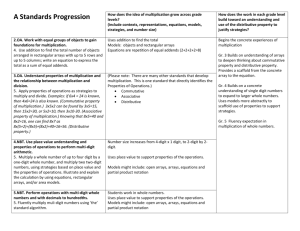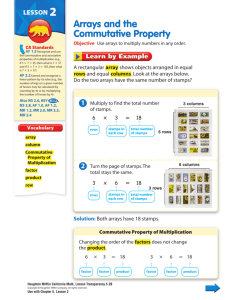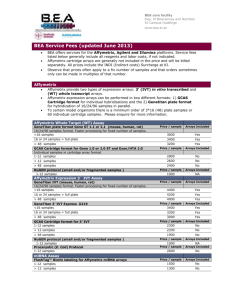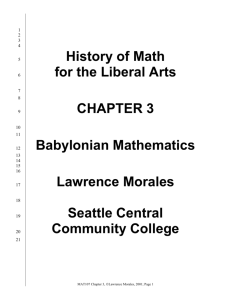NCEA Math Lesson Plan Grade: 4 Subject: Mathematics Domain
advertisement
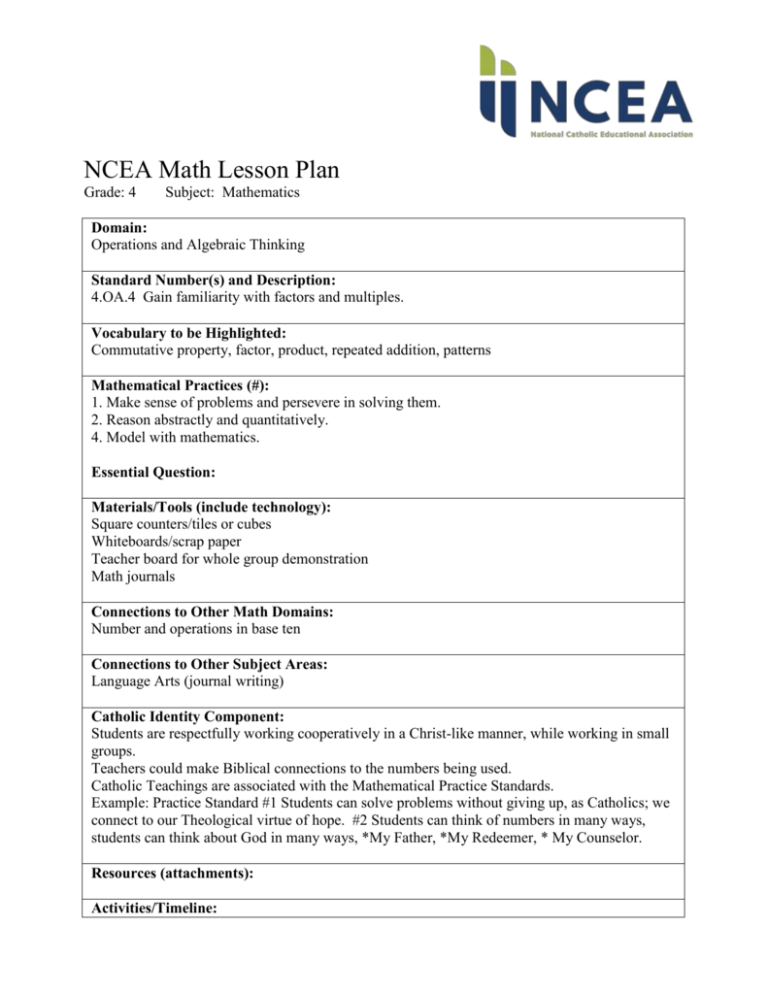
NCEA Math Lesson Plan Grade: 4 Subject: Mathematics Domain: Operations and Algebraic Thinking Standard Number(s) and Description: 4.OA.4 Gain familiarity with factors and multiples. Vocabulary to be Highlighted: Commutative property, factor, product, repeated addition, patterns Mathematical Practices (#): 1. Make sense of problems and persevere in solving them. 2. Reason abstractly and quantitatively. 4. Model with mathematics. Essential Question: Materials/Tools (include technology): Square counters/tiles or cubes Whiteboards/scrap paper Teacher board for whole group demonstration Math journals Connections to Other Math Domains: Number and operations in base ten Connections to Other Subject Areas: Language Arts (journal writing) Catholic Identity Component: Students are respectfully working cooperatively in a Christ-like manner, while working in small groups. Teachers could make Biblical connections to the numbers being used. Catholic Teachings are associated with the Mathematical Practice Standards. Example: Practice Standard #1 Students can solve problems without giving up, as Catholics; we connect to our Theological virtue of hope. #2 Students can think of numbers in many ways, students can think about God in many ways, *My Father, *My Redeemer, * My Counselor. Resources (attachments): Activities/Timeline: Students will be assigned to work in small groups. 1. Teacher will name or count out a specific number of tiles, for example #24. Students will count out rectangular arrays to identify the factors. 2. Students will count length and width of each new rectangle that is built. Have students record the different arrays. 3. Students will observe the patterns; they will discuss with their group their discoveries. What connections can they make? *Can they identify the repeated addition? 4. Students will write multiplication sentences using the lengths and widths of arrays. 5. Students will group the opposites together (example 3x8, and 8x3) to demonstrate the commutative property concept. 6. Students in a group will pair up. Each person uses a white board to display one length number and one width number from an array. Each group tries to represent all arrays that were made. 7. Teacher displays the word “length” and the word “width” on the board with a multiplication sign between. Teacher also needs to include an equal sign and the product. For example, Length X Width= 24 8. Students come up in pairs and stand in front of “length” and “width” while holding their number. (Students can make the connection to the math number sentence at this point.) 9. Teacher will substitute the words “length” and “width” with “factor.” This will introduce the vocabulary concept of “factor.” The teacher can also write the vocabulary word “product” above “24.” 10. Have pairs of students continue to demonstrate the multiplication sentences as factors. Student pairs will be asked to “commute” to each other’s place, thus making the connection to the Commutative Property of Multiplication. 11. An extension on this activity would be Math journal writing using the factors and products to tell a story, or create math word problems for others to solve. The ultimate goal is to make “factor books” with the students. To make a factor book, students should make a mini-book with one hundred pages. Students should number the pages at the top and then underneath each digit, students list all factors of that number. Students can work individually at first to list factors of simple numbers that are known quickly and after a short amount of time groups can use the counters to find factors by making arrays. This activity should take several days to complete, but the factor book can be used as a resource throughout the school year. These books come in handy when students are simplifying fractions just as one example. An extension for the above activity is to have the students locate the number from 1 to 100 that has the most factors, the least factors, etc. What patterns can the students find for odd numbers? Even numbers? Locate prime numbers and study their factors. Locate composite numbers and study their factors. This lends itself to so many ways to learn! Formative Assessment (what to look for, how/when to look): Teacher walks around to visually check arrays, and listen for student engagement. Sharing the short stories with other groups, or word problems. Summative Assessment: Student factor books, with numbers 1- 100. Math quizzes throughout year.


